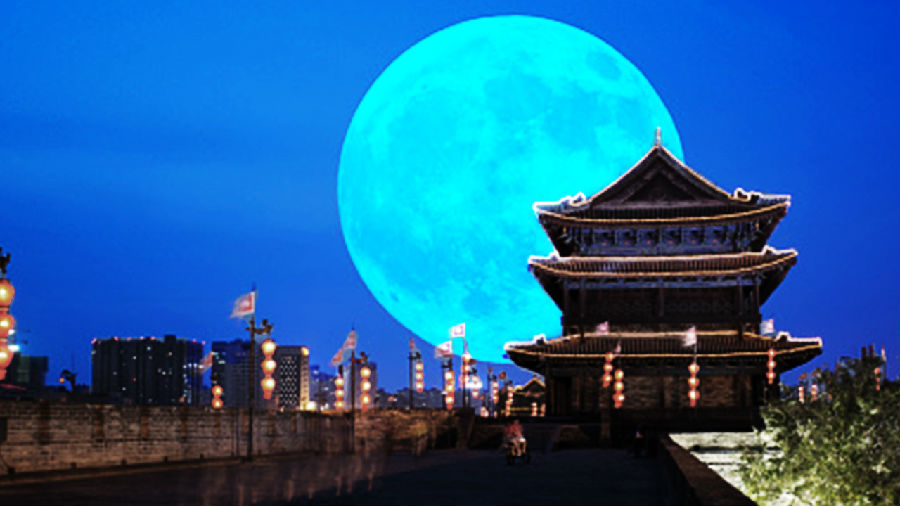(单词翻译:单击)
Guess what? China has announced plans to launch an “artificial moon” into our skies by 2020.
你猜怎么着?中国宣布了多项在2020年之前向太空发射“人造月亮”的计划。
And, as crazy as that sounds, it’s not actually the first time something like this has been attempted.
听起来很难以置信对不对,然鹅,这已经不是人类第一次做出类似的尝试了。
But first.
但首先。
China’s new plan.
这是中国的新计划。
As reported in China Daily, China plans to launch an “illumination satellite” into orbit above the city of Chengdu.
据《中国日报》报道,中国计划朝成都上空的轨道发射一颗“照明卫星”。
Well actually, four illumination satellites.
实际上是4颗照明卫星。
The first as a proof of concept in 2020 and the next three as the real deal in 2022.
2020年发射第一颗算作是对“照明卫星”这一概念进行实验验证,接下来预计在2022年发射的三颗就是来真的了。
There aren’t a ton of details about the satellites themselves yet,
虽然目前还没有很多关于这些卫星的具体细节,
like how big they are or what they will be made out of,
比如它们有多大,或者它们采用的是什么材料,
but we DO know they’ll be covered with a “reflective coating similar to the moon’s”
但我们的确知道,它们会被覆盖上一层“类似月球上那种的反射涂层”?
Whatever that’s supposed to mean.
先不管这句话到底是个什么意思。
At the proposed distance of 500km, a single satellite is expected to illuminate an area between 10 and 80 km,
在拟议的距地500公里的位置,一颗卫星预计将照亮10至80公里的区域,
with light around “8 times brighter” than the moon’s.
其亮度约为月球的“8倍”。
If all goes to plan, the scientists hope the moons will replace street lights in urban areas and save the city millions in electricity costs annually.
如果一切按计划进行,科学家们希望这些卫星能够取代城市地区的路灯,为城市节省每年支出的数百万美元的电费。
They could also help light up streets during natural disasters and blackouts.
这些卫星还可以在自然灾害和停电期间为街道照明。
Those same benefits are what prompted Russia to try something similar 20 years ago.
正是这些好处促使俄罗斯在20年前就尝试过建设类似的项目。
In 1993, Russia successfully deployed their own prototype of an illumination satellite, about a 20 meter reflective film that unfolded in space.
1993年,俄罗斯成功地部署了他们自己的照明卫星的雏形,一个在太空展开的大约20米长的反射膜。
For a few hours, it orbited a couple hundred meters above earth, beaming a 5km wide spotlight over Europe.
它在离地球几百米的高空绕轨道飞行了几个小时,照亮了欧洲地面上5公里宽的区域。
But, that light only moved at about 8 km/hour, meaning most people just saw a flash in the sky as it passed.
然而,那束光的移动速度为8公里/小时,这就意味着它经过时大多数人只看到了天空中有一道光一闪而过。
Eventually, it fell out of orbit and burned up on reentry.
最终,这个反射膜脱离了轨道,在重返大气层时化为了灰烬。
The Russians tried this again a few years later, this time with a 25 meter mirror.
几年后,俄国人又试了一次,这次用的是一面直径25米的镜子。
However, the satellite failed to deploy, and it quickly fell out of orbit.
然而,这颗卫星还没来得及正常运行就快速飞出了轨道。
There were plans to launch a third, even bigger mirror, but the project faced serious budgeting issues and was later abandoned.
他们原本还计划发射第三个比前一个还要大的镜子,但因为面临严重的预算问题,该项目后来被放弃了。
So China’s plan is essentially picking up where Russia left off,
所以,中国的计划基本上是在继续俄罗斯未完成的工作,
taking note of their mistakes and making something that will actually work, right?
吸取他们的教训,同时加入切实可行的设计,对吧?
Well, as critics have been quick to point out, that doesn’t appear to be the case.
不过,正如批评人士很快指出的那样,事实似乎并非如此。
The first, and probably biggest, issue with China’s proposed scheme concerns the height of orbit.
中国这次的计划的第一个问题,可能也是最大的一个问题,就是轨道的高度问题。
In order for a satellite to track a single city on earth, it would need to be in a geostationary orbit, about 36,000 km above earth.
要让一颗卫星追踪到地球上的某一个具体的城市,它需要处于与地球相对静止的轨道上,距离地球的高度在3.6万公里左右。
At the proposed 500 km, China’s satellites would face the same problem that Russia’s did,
在拟定的500公里的高度上,中国的卫星将面临与俄罗斯相同的问题:
whipping around earth, quickly lighting up random places for a fraction of a second as they go--- which isn’t exactly the goal.
绕着地球飞驰,在行进的过程中短暂而随机地照亮地球上的某些地方——并不一定就是那个真正的目标。
And even if 500km was a typo, and they meant to say 36 thousand,
即使500公里只是笔误,而他们真正想说的是3万6千公里,
a satellite at that height would need to be extraordinarily large - hundreds of meters across- to reflect much back to earth.
位置那么高的卫星就需要格外大——直径要在几百米宽——才能反射足够的光回地球。
And while the article doesn’t specify how big China’s sats will be, launching something big enough could be prohibitively difficult.
虽然文章没有具体说明中国的卫星将会有多大,但发射足够大的卫星可能会非常困难。
Critics also pointed out the plan has no mention of any sort of thrusters or fuel onboard these satellites.
批评人士还指出,该计划没有提到这些卫星上将会使用的任何推进器或燃料。
And that would probably be a necessity since out in space,
而到时候可能少不了要用到助推器或燃料,因为在外太空,
the satellites-- like the Russian mirrors-- will experience drag and solar radiation that will eventually push them out of orbit.
卫星——比如俄罗斯发射上去的镜子——会受到阻力和太阳辐射,最终将它们推离轨道。
The cost of the initial fuel and subsequent refueling missions could outweigh any savings in electricity costs on Earth.
而且,初始阶段的燃料和随后的燃料补给耗费的成本可能还会超过地球上能因此节省的所有电力成本。
Reportedly, researchers at several universities and institutes have looked over the plan and have given it the okay for trial,
据报道,几所大学和研究机构的研究人员已经仔细研究过这个计划,并同意对其进行试验,
so maybe we just don’t have all the details.
因此,也许只是我们不知道所有的细节罢了。
If that’s the case, and the plan does work, should we be worried?
如果真是这样,而且这个计划奏效了,那我们有必要担心吗?
Many scientists have expressed concerns that these satellites will amplify the light pollution problems we already have.
许多科学家担心,这些卫星会加剧目前已经存在的光污染问题。
Excess light from cities today alters night cycles of animals, the sleep cycles of humans, and disrupts astronomers’ view of space.
如今,城市产生的过量光线不仅改变了动物夜间活动的周期,也改变了人类的睡眠周期,还扰乱了天文学家对太空的观测。
And a project of this scale will likely make those problems worse.
如此规模的项目可能会让这些问题进一步恶化。
It’s not clear in the reports whether the Chinese government has given these plans any sort of official backing,
报告中没有清楚地说明中国政府是否对这些计划予以了任何官方支持,
So, I suppose for now, we’ll just have to wait and see if any new moons light up the sky.
所以,目前,在我看来,我们只能等待,看看是否有新的月亮照亮天空。


